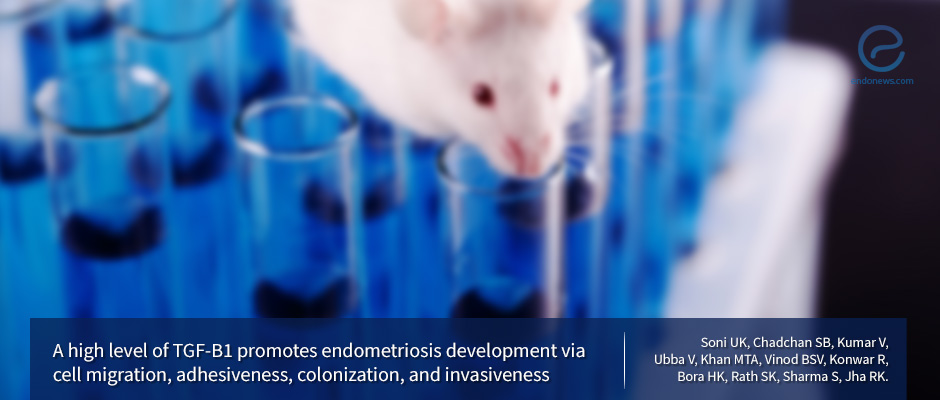Study Sheds Light on the Molecular Mechanism of Endometriosis Development
Mar 8, 2019
A better understanding of disease mechanism could help researchers find new ways to target and eliminate endometriosis.
Key Points
Highlights:
- A protein called TGF-B1 may be enhancing the ability of endometrial cells to migrate and stick to other areas in the abdominal cavity playing a crucial role in the development of endometriosis.
Importance:
- A better understanding of the molecular mechanisms of how endometriosis develops can help researchers come up with new strategies to treat the disease.
What's done here:
- Researchers used a mouse model of endometriosis, as well as ovarian endometriotic cysts lining cells to better understand the possible role of TGF-B1 in the endometriosis development.
Key results:
- Treating mice with endometriosis with TGF-B1 increased the growth of endometrial lesions.
- When TGF-B1 was given, adhesion molecules such as integrin beta3, integrin beta8, and FAK were upregulated in the endometrial lesions.
- Cell migration molecules such as phosphorylated E-cadherin, N-cadherin, and vimentin were enhanced in the endometrial lesions in the mouse model in the presence of TGF-B1.
- When TGF-B1 was administered, the expression of RHOGTPases (RAC1, RHOC, and RHOG) was increased in tissues from endometriosis mouse. This was also the case in human endometriotic cells derived from ovarian cyst cells obtained from endometriosis patients.
Limitations:
- This is a study conducted in a mouse model of endometriosis and may not reflect what is happening in the body of an endometriosis patient.
- Further research is needed to better understand all aspects of the disease and how different molecules may be interacting with each other to finally lead to the development of endometriosis.
Lay Summary
A protein called transforming growth factor-beta1 (TGF-B1) enhances the capacity of endometriotic cells or cells that make up the lining of the uterus to migrate, invade, and colonize other areas in the body. This is according to a study published in the scientific journal Biology of Reproduction.
Endometriosis is characterized by the growth of tissue resembling the endometrium or the lining of the uterus elsewhere in the body forming lesions. The exact cause of this is not known but one of the theories proposes that retrograde menstruation may, at least in part, play a role. During menstruation, some menstrual blood and cellular debris travel backward up the fallopian tubes, or the tubes connecting the ovaries to the uterus. This is called retrograde menstruation. Menstrual blood contains endometrial cells. According to the theory, these cells implant and start growing along the reproductive canal forming lesions and causing endometriosis.
The present study proposes that TGF-B1 plays a crucial role in this process, with elevated levels of the protein regulating the development of endometrial lesions. “ TGF-B1 establishes pelvic endometriosis by specifically enhancing the migration, attachment, proliferation, colonization, and invasion by floating endometriotic cells or tissues,” the researchers wrote. They suggested that it does this through complex biological pathways and signaling cascades such as the integrin-FAK, cadherin, and RHOGTPase signaling cascades.
It was already known that endometriosis is associated with increased levels of TGF-B1, but the exact role of the protein in the development of the disease and how it affects downstream signaling pathways were not well understood.
Here, a team of researchers from India elucidated the potential role of TGF-B1 in the development of endometriosis using a mouse model. First, they induced endometriosis in the animals by surgically transplanting endometrial tissue to the peritoneal regions or the space within the abdomen that contains the intestines, stomach, and liver. They then increased the concentrations of TGF-B1 in the animals.
They found that higher levels of TGF-B1 increased the growth of endometrial lesions in the animals. They also found that adhesion molecules or molecules that help cells stick together such as integrins and FAK were produced at higher levels in these lesions when animals were given TGF-B1.
TGF-B1 also enhanced phosphorylated E-cadherin, N-cadherin, and vimentin, molecules that are known to be crucial players in cell migration.
The researchers also directly treated human endometriotic cells and tissues from the mouse model of endometriosis with TGF-B1. They saw that this led to the production of enzymes called RHOGTPases that are also important for cell migration and cell adhesion.
The researchers concluded that TGF-B1 plays a role in the adhesion of endometrial cells in the peritoneal cavity by enhancing the integrin- and FAK-signaling pathway and in cell migration via cadherins and RHOGTPases.
Research Source: https://www.ncbi.nlm.nih.gov/pubmed/?term=30423016
Cell signaling cell migration TGF-B1 mouse model

